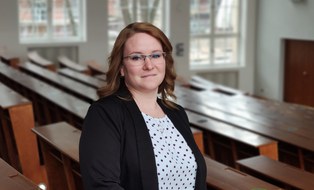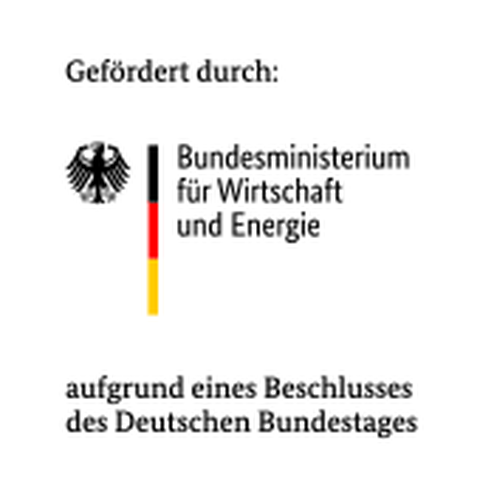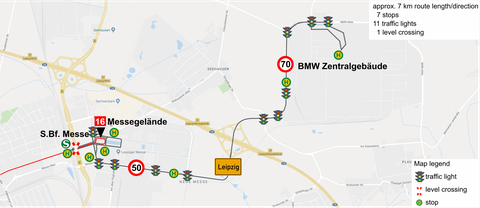ABSOLUT - AUTOMATED BUSSHUTTLE - SELFORGANIZING BETWEEN LEIPZIG AND THE BMW-TERMINAL
KEY DATA
Project duration: 01st January 2019 – 31st December 2021 (extended until 30th September 2022)
Funding Organization: Federal Ministry for Economic Affairs and Energy, Strategic Individual Project „ICT for Electric Mobility III“
Funding amount: 10.0 million euros, of which 6.2 million euros - Technical University of Dresden
MOTIVATION
There are a large number of demonstration projects in Germany and Europe with slow (< 20 km/h) automated shuttles in local public transport [https://www.vdv.de/innovationslandkarte.aspx]. However, only a few of these projects address the technological advancement to speeds suitable for public transport (< 40 km/h) in order to enable competitive travel times to the prevailing individual transport.
This is where the ABSOLUT project comes in: It will investigate and demonstrate which vehicle and infrastructure technologies are necessary to fully integrate these minibuses, which have been converted for automated driving, into the local public transport system in suburban areas and to use them to transport passengers safely and on demand.
ABSTRACT PROJECT OBJECTIVES
-
Technology development of automated bus shuttles with local speed (40 - 70 km/h) to demonstrate driverless (level 4 public transport) public transport operation in public transport areas
-
Expansion of driving area and situation control compared to current projects on "virtual rail", which have as their goal pure collision avoidance
-
Presentation of scheduled operations with on-demand support and on-demand transport by networking of customers, control center, vehicles and transport infrastructure to optimize connection security and traffic quality (demand-oriented public transport prioritization)
PROJECT DESCRIPTION
 © VPA
© VPA
Secretary
NameHeike Seifert
Send encrypted email via the SecureMail portal (for TUD external users only).
Chair of Traffic Process Automation
Chair of Traffic Process Automation
Visiting address:
Gerhart-Potthoff-Bau, Room POT 57 Hettnerstraße 3
01069 Dresden
Consortium management: Leipziger Verkehrsbetriebe (LVB) GmbH
Internal project partners: Chair of Vehicle Mechatronics, Institute of Leightweight Engineering and Polymer Technology, Chair of Automobile Engineering, Chair of Computer Graphics and Visualization
External project partners: City of Leipzig, Leipziger Verkehrsbetriebe (LVB) GmbH, INAVET GmbH, BitCtrl Systems GmbH, Apinauten GmbH, FSD Fahrzeugsystemsdaten GmbH, glts cotech GmbH, IAV GmbH, Sedenius Engineering GmbH, Virtence GmbH
The Chair of Traffic Control and Process Automation (VLP) is leading work package 5 in the ABSOLUT project with the research focus on "infrastructure upgrading", which is being carried out with the participation of the external partners
- Institut für angewandte Verkehrstelematik INAVET GmbH
- City of Leipzig
and the consortium leader
The core idea of ABSOLUT is the development of vehicles and their exemplary use for the test track S-Bahnhof Messe to BMW plant with local speeds and high automation, which will be integrated in the future of the transport services of the Leipziger Verkehrsbetriebe.
In addition to the testing and approval of the vehicles, the subject of development is also the pilot operation in public space for testing various deployment concepts. This includes an on-demand 24/7 offer, a booking and information interface developed with the users and the establishment and networking with a control center. Accompanying the study is the user acceptance of autonomous bus traffic.
In the project, business, science and the city of Leipzig work closely together with the transport companies that have taken over the project management. For the predominantly Saxon partners, including small and medium-sized companies, it is possible in the field of digital and communication technologies as well as artificial intelligence to apply and expand the existing competences in order to strengthen the economic and scientific location of Saxony for the future.
The project is a key component of future mobility and is funded by the Federal Ministry for Economic Affairs and Energy. It also reflects the objective of the Free State of Saxony to develop and promote concrete pilot projects for the development and development of autonomous transport systems.
The test route stretches from the Messe S-Bahn station to the BMW plant. This is primarily intended to expand the mobility offer for the northern area of Leipzig. The test route is approx. 7 km long in each direction from the Messe S-Bahn station to the BMW factory site and is characterised by different route characteristics. As part of the ABSOLUT project, a corridor of Cooperative Intelligent Transport Systems (C-ITS) is being built for highly automated public transport. For this purpose, all traffic lights on the route as well as a (road) level crossing will be equipped with roadside units (ETSI ITS-G5). For networked applications, public 5G mobile radio coverage is also available for the next project phase.
Route characteristics:
- All junctions signalised, 11 traffic signals; 1 level crossing (tram).
- Shared space (up to 20 km/h) on trade fair grounds and BMW car park, multi-lane roads with large volumes of heavy traffic and little pedestrian and cycle traffic (50-70 km/h); bus traffic and bus stop areas; bridge structures
- Optimal sensor concept and design methodology, sensor data fusion, computer vision and model-based object classification for comprehensive and robust object recognition
- Design of vehicle wiring systems and E/E architecture for X-by-Wire vehicles and fully automated driving
- Model-predictive online longitudinal and lateral vehicle control using optimal control methods for safety- and comfort-optimised driving, taking into account release times at traffic signals, traffic situations and loading status
- Continuous design and assurance chain for highly automated driving functions and concepts for standardised approval
FOCUS WORKPACKAGE 5 "Infrastructure Upgrade"
In contrast to other research projects, the ABSOLUT project is constantly exploring the boundaries between the sufficient and necessary infrastructure measures for automated driving. Since both a cross-area over-planning of roads, junctions, etc. as well as the area-wide use of the most diverse sensor and communication technologies do not seem feasible in the near future.
Of central importance with regard to the transfer to the tram and city railway is the trade fair area, which is structurally reminiscent of a shared space, which in its original planning was not designed for road-based public transport in regular operation. Missing markings, unsignalised intersections, GNSS shadowing and heavy pedestrian traffic represent the greatest challenges for an automated vehicle, which can currently only be met by reducing the vehicle speed and additional reference markers to support the positioning functions.
The vehicle receives the following protocols standardised according to ETSI from a roadside unit on the respective control unit of the traffic signal system:
- SPaTEM (Signal, Phase and Timing Extended Message).
- MAPEM (Map Extended Message).
This ensures that the vehicle always receives information on the position of the relevant signalling device, its current signal status and the duration of the signal phase.
Furthermore, the vehicle sends out the protocol CAM (Cooperative Awareness Messages), which is also standardised according to ETSI, or CAM-R09 for public transport vehicles. With the help of this message, the vehicle is registered and deregistered at the traffic light system.
The once applied first-in-first-out principle has been outdated for years. In the meantime, an overall consideration of the traffic situation at the intersection is up-to-date. Accordingly, the needs of the individual traffic flows are determined and weighed up against each other for quality-oriented public transport priority. A decision-making system maps the logic of the respective intersection and selects the optimal public transport priority based on the knowledge of the public transport operating situation, the private transport traffic situation and the current status of the traffic light control system.
This type of public transport priority has already been used for several years in the state capital Dresden and in the city of Leipzig at more than 20 junctions, see the projects "Chamäleon" and "Stadtring", and is currently planned for a large number of other junctions.
In the ABSOLUT project, quality-based public transport priority is also applied. Due to the automation, the precise vehicle position is known in real time, which means that a minimal and correspondingly more effective intervention in the LSA control or in the coordination along the route can be made.
To support precise location and better planning of driving manoeuvres, the automation systems in the vehicles need digital map material of the test track. This is a highly accurate 3D model of the infrastructure that is enriched with additional data content. For example, all traffic signs are stored with their content and assigned to the respective road sections.
OpenDRIVE was chosen as the starting format for the digital map material because of its application and distribution in the field of driver assistance systems and its possible integration into various development environments and simulation tools. This format makes it possible to describe and link elements of road networks in an XML-based manner.


